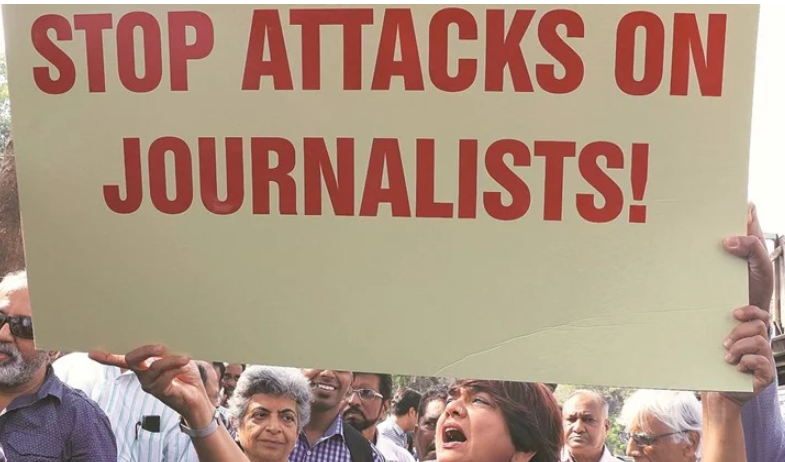Over 200 Attacks on Journalists in 6 Years, Near Zero Convictions, Says Study

Representational Image. Image Courtesy: Indian Express
New Delhi: Amid protests against the Citizenship Amendment Act and National Register of Citizens flaring up across the country and consequent suppression tactics adopted by the government against the protesters, journalists, too, have come under attack in several places.
From Assam to Uttar Pradesh, Delhi and Karnataka, journalists have reportedly been detained, assaulted, their camera equipment snatched and even banished into a neighbouring state, says a recent report released by the Thakur Family Foundation, which works among communities in the field of public health, right to information and civil liberties.
The report, Getting Away with Murder: A Study on the Killings of and Attacks on Journalists in India, 2014-2019, and Justice Delivery in These Cases, states that over 200 serious attacks on journalists have been recorded in India since 2014. The study also stated that in these cases, where journalists have been targeted for their investigative work, there have not been any single conviction so far.
In addition to the attacks, journalists are rendered further defenceless by the failure of the system to ensure justice. At least 36 instances of attacks on journalists have been reported in 2019 itself, out of 198 serious instances of attacks on journalists between 2014-19, according to the report.
“Reports show that the number of journalists killed in 2019 is seven but preliminary investigations indicate that only one, the killing of K Satyanarayana in Andhra Pradesh, was linked to the journalist’s professional work,” it stated.
Also read: CAA/NRC: Journalists Covering Protests Face Police Ire Across States
The report also talks about the recent detantion of seven journalists from Kerala in Mangaluru by Karnataka police during the CAA/NRC proetsts for “holding an accreditation from the neighbouring Kerala, which Karnataka police considered invalid.” The journalists were then transported to Thalapaddy across the border where they were dropped. They were later released after protests from the fraternity and intervention by the Kerala chief minister.
In another incident, the UP correspondent of The Hindu, Omar Rashid, was detained by police for several hours and subjected to communal abuse. He was released after being questioned about his credentials as well as his origins as a Kashmiri journalist.
As far as justice delivery is concerned, the report notes that the pattern of obfuscation and delay was replicated in almost all the cases tracked by the study. In the cases of killings of 20 journalists and 63 attacks on journalists targeted for their investigative work between 2014-18, there have been near-zero convictions.
The report also notes that, “Apart from prominent editors and senior journalists like Gauri Lankesh and Shujaat Bukhari and J Dey, killed in state capitals, a majority of the journalists killed belong to small towns and villages, working with regional media as correspondents or stringers.
According to a release by the foundation, the objective of the study was to document cases of deaths and attacks on journalists from 2014-18, determine the status of justice in these cases as well as make recommendations on how best to tackle the increasing attacks on journalists and secure justice for them as well as how to safeguard the work they do.
Some of the highlights of the report are given below:
• There were 40 killings of journalists between 2014-19. Of these, 21 have
been confirmed as being related to their journalism.
• Of the over 30 killing of journalists since 2010, there were only three
convictions. The cases were J Dey, killed in 2011; Rajesh Mishra, killed in
2012 and Tarun Acharya, killed in 2014.
• In a fourth case of journalist Ram Chandra Chhattrapati, killed in 2002, it
took 17 years for justice to be delivered in the life imprisonment order for
Dera Sacha Sauda chief Gurmeet Ram Rahim.
• The study documented 198 serious attacks on journalists in the period
between 2014-19, including 36 in 2019 alone.
• Journalists have been fired upon, blinded by pellet guns, forced to drink
liquor laced with urine or urinated upon, kicked, beaten and chased. They
have had petrol bombs thrown at their homes and the fuel pipes of their
bikes cut.
• Journalists covering conflict or news events were specifically targeted by
irate mobs, supporters of religious sects, political parties, student groups,
lawyers, police and security forces.
• Attacks on women journalists in the field were found to have increased.
The targeted attacks on women journalists covering the Sabarimala
temple entry were sustained and vicious. A total of 19 individual attacks of
women journalists are listed in this report.
• Perpetrators of the killings and attacks included government agencies,
security forces, political party members, religious sects, student groups,
criminal gangs and local mafias.
Also read: DUJ Flays Attacks on Journalists in Kashmir, Kerala
Get the latest reports & analysis with people's perspective on Protests, movements & deep analytical videos, discussions of the current affairs in your Telegram app. Subscribe to NewsClick's Telegram channel & get Real-Time updates on stories, as they get published on our website.























